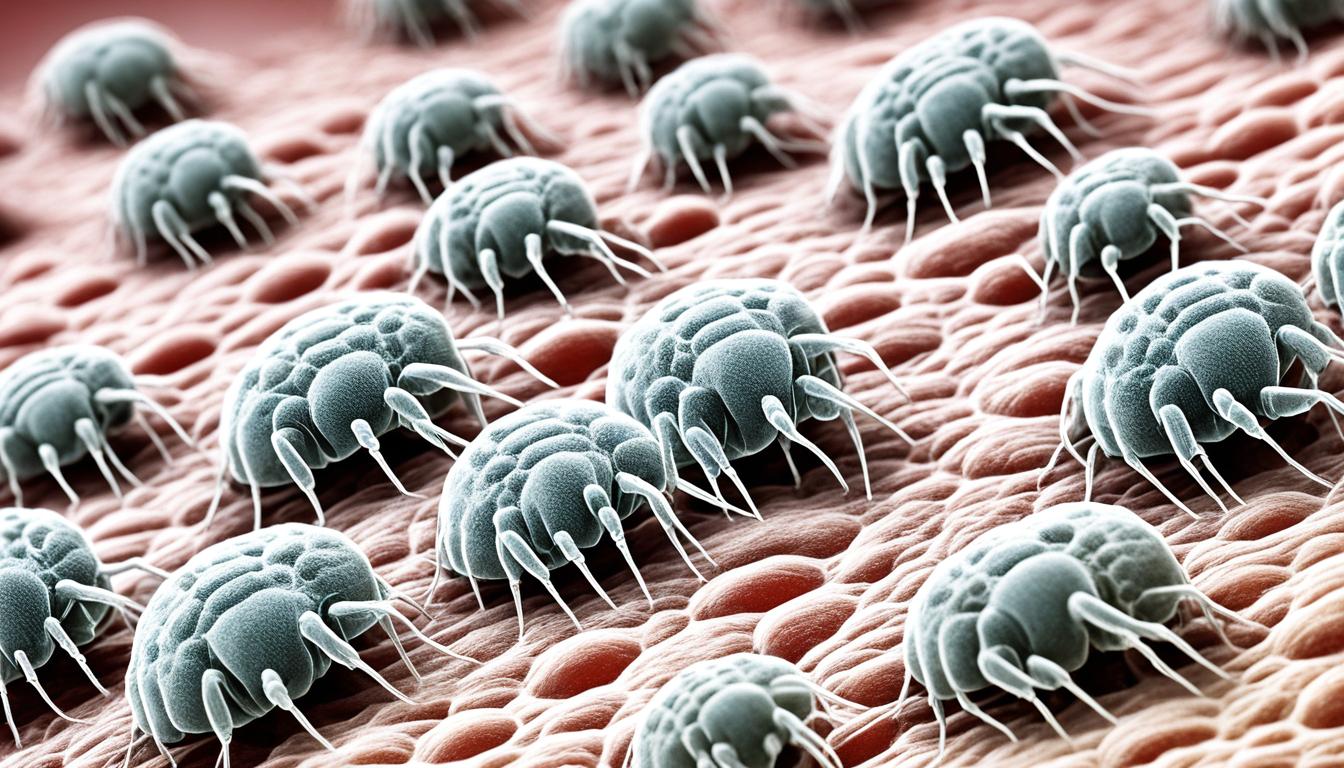Dust mite allergy is a common problem. It happens when a person’s immune system reacts to dust mite proteins. This can cause sneezing, a runny nose, itchy and watery eyes, coughing, and wheezing. These symptoms can be worse for people who have asthma and dust mite allergy.
To diagnose this allergy, doctors use skin prick tests or blood tests. A positive test means you are allergic to dust mites.
There are a few ways to treat this allergy. One option is to avoid dust mites. You can do this by using special bedding and cleaning your home often. Medicines like antihistamines and nasal sprays can also help. They lessen symptoms.
Another treatment is immunotherapy. This is a long-term solution that aims to make your body less sensitive to dust. It does this by giving your body small doses of the allergen over time. You can get these through shots or tablets.
Key Takeaways:
- Dust mite allergy is a common allergic condition triggered by an immune response to dust mite proteins.
- Symptoms of dust mite allergy include sneezing, runny nose, itchy and watery eyes, coughing, and wheezing.
- Diagnosis is usually done through skin prick tests or blood tests that measure specific IgE antibodies.
- Treatment options include allergen avoidance, medication, and immunotherapy.
- Preventive measures such as dust mite-proof bedding and regular cleaning can help reduce allergic reactions.
Managing Dust Mite Allergies: Prevention and Relief Strategies
Managing dust mite allergies combines prevention and relief methods. These strategies help lessen symptoms and reduce dust mite exposure. This can make life better.
Prevention Strategies
To stop dust mite allergies, make your place unwelcoming for them. Here are some tips to help:
- Use allergen-proof covers for mattresses, pillows, and bedding to create a barrier between the dust mites and the individual.
- Wash bedding regularly in hot water (at least 130°F) to kill dust mites and remove allergens.
- Maintain low humidity levels in the home (aim for below 50%) as dust mites thrive in humid environments.
- Reduce dust accumulation through frequent vacuuming with a HEPA filter and dusting with a damp cloth.
Work these steps into your routine to lower dust mite exposure. This can cut down on allergic reactions.
Relief Strategies
If you’re feeling the effects of a dust mite allergy, several strategies can offer relief:
- Over-the-counter antihistamines can provide temporary relief from symptoms such as sneezing, itching, and runny nose.
- Nasal sprays containing corticosteroids can help reduce nasal inflammation, congestion, and improve breathing.
- Using dehumidifiers can help maintain optimal humidity levels in your home, creating an environment less favorable for dust mites.
- Air purifiers equipped with HEPA filters can trap and remove allergens from the air, reducing your exposure to dust mite particles.
If symptoms are bad or continue, seeing a doctor is wise. They could prescribe medicine for long-term relief or suggest immunotherapy as a treatment.
Following these tips on prevention and finding relief can help you handle dust mite allergies better. This improves your health and well-being.
Stem Cell Therapy for Dust Mite Allergy: A Revolutionary Potential Treatment
Stem cell therapy is a new hope for those fighting dust mite allergies. Studies show that these cells can help the body adjust to allergens. For instance, a study on venom allergies found that using stem cells led to more of a certain T cell type. This change lowered the levels of IgE, which is key in allergies.
Another study focused on house dust mite allergies. It showed a drop in certain cytokines and a boost in IFN-gamma. IFN-gamma helps the immune system fight off threats. These findings hint that stem cell therapy might become a major treatment in the future for dust mite allergy.
Although this therapy is still being tested, its potential looks bright. We need more studies to confirm its safety and effectiveness. The idea of using stem cells to adjust how the immune system reacts to dust mites is exciting. It suggests we could see major improvements in treating this common allergic condition.
Advancing in this area, tests for dust mite allergy and stem cell therapy are very interesting. Scientists and doctors are excited about the healing abilities of stem cells. They believe they could create personalized treatments for dust mite allergies. This could change how we handle these allergies in the future.

